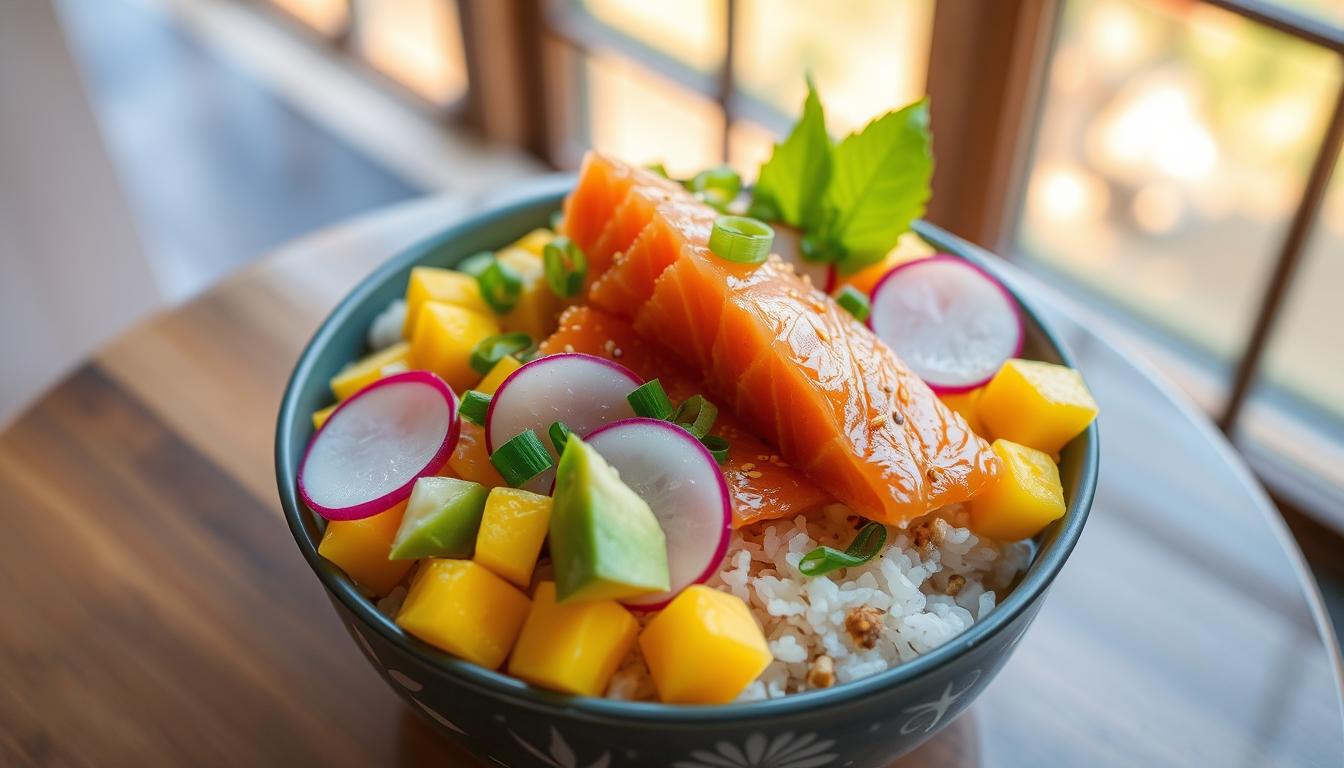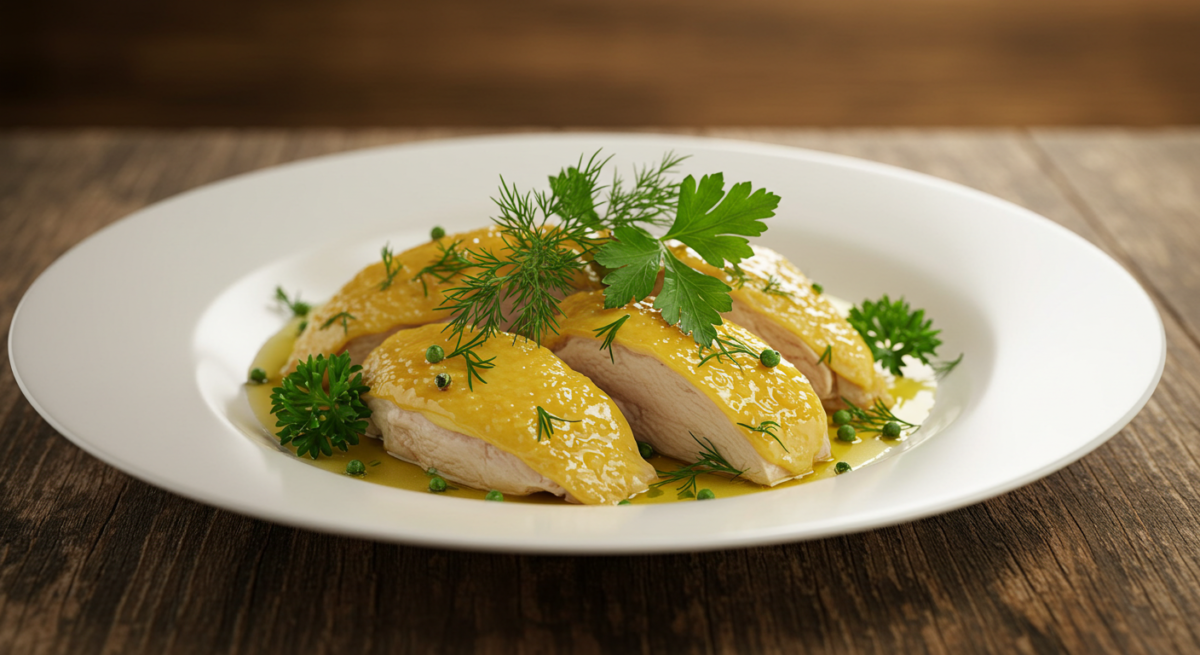Imagine enjoying a dish that’s both healthy and full of flavor. That’s what you get with a perfectly cooked seared ahi tuna. It’s loved worldwide for its simplicity and rich taste, making it a top pick for seafood fans.
Cooking ahi tuna by searing brings out its natural flavors. It also makes the tuna tender and juicy. This dish is great as a main course or part of a bigger meal. With the right cooking methods, you can make a restaurant-quality seared ahi tuna right at home.
Key Takeaways
- Seared ahi tuna is a healthy and flavorful dish.
- It’s a simple recipe to prepare at home.
- Ahi tuna can be cooked in various ways, with searing being a popular method.
- The dish is versatile and can be served in multiple settings.
- Using the right cooking techniques is key to a perfect seared ahi tuna.
Introduction to Ahi Tuna
Ahi tuna is a fish that’s great for many cooking methods. It has a meaty texture and a rich flavor. This makes it a hit with seafood lovers. We’ll look at what ahi tuna is, its health benefits, and how versatile it is in cooking.
What is Ahi Tuna?
Ahi tuna, also known as yellowfin tuna, is a type of tuna. It’s known for its tender flesh and rich taste. It’s a popular choice in sushi and sashimi because of its texture and flavor.
It has a firm texture and rich, meaty flavor. This makes it good for many cooking methods, like grilling, searing, and baking.
Health Benefits of Ahi Tuna
Ahi tuna is not just tasty but also full of nutrients. It’s an excellent source of protein and has lots of omega-3 fatty acids. These are good for the heart and brain.
| Nutrient | Benefit |
|---|---|
| Protein | Essential for muscle repair and growth |
| Omega-3 Fatty Acids | Supports heart health and brain function |
| Vitamin D | Important for bone health and immune function |
Cooking Versatility
Ahi tuna is great because it can be cooked in many ways. You can sear, grill, or bake it. The key is to not overcook it, so it stays tender.
Whether you’re making a simple seared ahi tuna dish or trying something more complex, ahi tuna will impress. It’s perfect for absorbing flavors, making it great with different marinades and seasonings.
Essential Ingredients for Seared Ahi Tuna
Making a tasty seared ahi tuna dish begins with knowing the key ingredients. You need to pick the right tuna and add the right flavor enhancers and marinades.
Choosing the Right Ahi Tuna
The quality of the tuna is crucial for seared ahi tuna. Look for sushi-grade ahi tuna that’s firm and has a deep red color. Fresh tuna greatly affects the dish’s taste and texture.
Additional Flavor Enhancers
To make your seared ahi tuna even better, add some extra flavor enhancers. Here are some great options:
- Soy sauce for a savory umami taste
- Garlic for a pungent flavor
- Ginger for a warm, spicy kick
- Sesame oil for a nutty, aromatic flavor
You can mix these ingredients to create a marinade or seasoning that goes well with the tuna.
Recommended Marinades
A good marinade can really enhance your seared ahi tuna’s flavor. Here are some top marinades:
- A mix of soy sauce, garlic, and ginger for an Asian twist
- Olive oil, lemon juice, and herbs for a Mediterranean flavor
- A spicy marinade with chili flakes and lime juice for a bold taste
Try out different marinades to find the perfect flavor for your seared ahi tuna. The goal is to balance the flavors so they don’t overpower the tuna’s natural taste.
Preparing Ahi Tuna: Step-by-Step
To get a perfectly seared ahi tuna, start with the right preparation. This includes several important steps. These steps make sure your dish is tasty and cooked just right.
Thawing Frozen Ahi Tuna
If your ahi tuna is frozen, thaw it first. You can thaw it in the fridge overnight or in cold water for 30 minutes to an hour. Never thaw ahi tuna at room temperature or in hot water, as it can grow bacteria and spoil the fish.
After thawing, dry the tuna with paper towels. This removes extra moisture. It’s key for a great sear.
Preparing Your Workstation
Before cooking, get your workstation ready. You’ll need all your ingredients and tools close by. For searing ahi tuna, use a hot skillet, like cast-iron or stainless steel, and oil with a high smoke point, like avocado oil.
- Season the ahi tuna with your desired seasonings.
- Heat the skillet over high heat until it’s almost smoking.
- Add a small amount of oil to the pan and swirl it around.
Searing Techniques
Searing ahi tuna needs a hot pan and some technique. Put the tuna in the skillet, away from you to avoid splashing oil. Sear for 1-2 minutes on each side, depending on the tuna’s thickness and your desired doneness.
For a rare to medium-rare finish, don’t overcook the tuna. Use a thermometer to check for an internal temperature of 120°F to 130°F (49°C to 54°C) for medium-rare.
The Perfect Seared Ahi Tuna Recipe
Seared ahi tuna is a culinary delight that’s simple yet sophisticated. It’s impressive and easy to make, perfect for any occasion. Whether it’s a special event or a weeknight dinner, this dish is a hit.
Recipe Overview
This seared ahi tuna recipe highlights the fish’s natural flavors with a tasty crust. You’ll need fresh or frozen ahi tuna steaks, quality oil for searing, and your favorite seasonings. The secret to success lies in the ingredients and technique.
Ingredients:
- 4 ahi tuna steaks (about 1 inch thick)
- 2 tablespoons olive oil
- 1 tablespoon soy sauce
- 1 tablespoon sesame oil
- 2 cloves garlic, minced
- 1 teaspoon grated ginger
- Salt and pepper to taste
- Optional: sesame seeds and chopped green onions for garnish
Cooking Time and Temperature
Cooking ahi tuna to the right doneness is key. You want a nice crust on the outside and a rare or medium-rare inside. Preheat your skillet to high heat. Sear the tuna for 1-2 minutes on each side, depending on thickness and desired doneness. Use a meat thermometer to check for 120°F – 130°F for medium-rare.
Serving Suggestions
Let the tuna rest for a minute before slicing it thinly against the grain. Serve it right away with steamed veggies, a fresh salad, or a flavorful rice dish. For extra flavor, drizzle with soy sauce or a citrus-herb marinade. Top with sesame seeds and green onions for a fancy touch.
By following this recipe, you’ll make a dish that’s both delicious and beautiful. It’s perfect for any meal, whether it’s for yourself or to impress guests.
Pairing Options for Ahi Tuna
To make ahi tuna even better, try these pairing options. Ahi tuna goes well with many dishes, making it a versatile choice.
Best Sides to Complement Ahi Tuna
Choosing the right sides is key. They should balance flavors and textures. Here are some great choices:
- Roasted vegetables like asparagus or Brussels sprouts
- Saffron rice or quinoa for a flavorful base
- Grilled or steamed green beans for a crunchy contrast
For more ideas, check out this table. It lists popular sides and their characteristics:
| Side Dish | Flavor Profile | Texture |
|---|---|---|
| Roasted Asparagus | Earthy, slightly bitter | Tender |
| Saffron Rice | Rich, aromatic | Fluffy |
| Grilled Green Beans | Smoky, slightly charred | Crunchy |
Wine Pairing Recommendations
Wine can make your meal even better. For ahi tuna, pick wines that match its flavor. Here are some good choices:
- Pinot Grigio for its crisp acidity
- Sauvignon Blanc for its citrus notes
- Light-bodied reds like Pinot Noir for a subtle complement
Salad Ideas for a Fresh Touch
A fresh salad can add a nice contrast to ahi tuna. Try these salad ideas:
- Mixed greens and a citrus vinaigrette
- Avocado and cherry tomatoes for creaminess and sweetness
- Pickled ginger for an Asian-inspired twist
With these pairing options, you can make a memorable meal with ahi tuna.
Tips for Cooking Ahi Tuna
Cooking ahi tuna right needs focus and some expert advice. Whether you’re a pro in the kitchen or just starting, knowing how to cook this fish can make your meals better.
Avoiding Common Mistakes
One big mistake is overcooking ahi tuna. It’s best when it’s seared on the outside and rare inside. If you overcook it, the fish will be tough and dry.
- Make sure your pan is hot before adding the tuna for a good sear.
- Don’t put too much tuna in the pan at once; cook them one by one if needed.
- Use a timer to avoid overcooking.
Using a Meat Thermometer
A meat thermometer is very helpful when cooking ahi tuna. It helps you get the perfect doneness. For ahi tuna, the internal temperature should be at least 145°F (63°C) for medium-rare. But many chefs like it even rarer.
Recommended Internal Temperatures:
| Rare | Medium-Rare | Medium |
|---|---|---|
| 115°F – 120°F | 125°F – 130°F | 140°F – 145°F |
Benefits of Resting the Fish
Letting the fish rest after cooking makes it more tender and flavorful. This simple step can really improve your meal.
“Resting fish is like letting a fine wine breathe; it lets the flavors mature and blend, making the taste more complex and satisfying.”
To rest ahi tuna, take it off the heat and let it sit for a few minutes before serving. This method keeps the fish moist and tender.
Storing Leftover Ahi Tuna
Wondering how to store leftover ahi tuna? It’s important to keep it fresh and safe to eat. Whether you cooked too much or want to save some, proper storage is key.
How to Properly Store
Cool the tuna down to room temperature within two hours. This stops bacteria from growing. Then, put it in an airtight container and wrap it tightly with plastic or foil.
Tip: For longer storage, freeze the tuna. Wrap it in plastic or foil and put it in a freezer-safe bag. Frozen tuna can last up to 3 months.
Reheating Tips
Reheating ahi tuna needs care to keep it tender and flavorful. The best way is to gently heat it in a pan with a bit of oil over low heat. Turn it often to avoid overcooking.
Avoid reheating ahi tuna in the microwave if possible, as it can become tough and dry. If you must use a microwave, heat it in short intervals, checking until it’s warmed through to your liking.
Creative Leftover Recipes
Leftover ahi tuna can be used in many dishes. Try making a tuna salad with mayonnaise, onions, and celery. Serve it on greens or as a sandwich filling.
Another idea is to use leftover ahi tuna in sushi or sashimi, if it’s fresh enough and has been stored properly. You can also flake the tuna and add it to pasta dishes or salads for a protein-packed meal.
As Chef Gordon Ramsay once said, “The key to a great dish is not just in its preparation but also in its presentation and the love you put into it.” Repurposing leftover ahi tuna into new meals not only reduces waste but also allows you to explore different flavors and cuisines.
Ahi Tuna Variations to Try
There’s more to ahi tuna than just searing. You can turn it into many tasty dishes that look great too. Try new recipes to explore different flavors and textures.
Blackened Ahi Tuna
Blackened ahi tuna is a tasty twist. It’s made by coating the fish in spices and searing it in a skillet. This method gives a crispy outside and a soft inside.
To make blackened ahi tuna, you need ahi tuna steaks, a spice mix, and a hot skillet. Coat the tuna with the spice mix and sear it for 1-2 minutes on each side.
Ahi Tuna Tartare
Ahi tuna tartare is a fresh, elegant dish. It’s perfect for appetizers or light meals. It’s made by finely chopping sashimi-grade tuna and mixing it with soy sauce, sesame oil, and diced veggies.
To make ahi tuna tartare, you need sashimi-grade tuna, soy sauce, sesame oil, and other ingredients like diced onions or avocado. Mix everything gently to keep the tuna tender.
Grilled Ahi Tuna Skewers
Grilled ahi tuna skewers are fun and easy. They’re great for outdoor gatherings or barbecues. You thread tuna chunks onto skewers, brush them with marinade, and grill until done.
For grilled ahi tuna skewers, you need tuna chunks, skewers, and a marinade. Use olive oil, lemon juice, and herbs for the marinade. Brush the marinade on the tuna before grilling over medium-high heat.
| Variation | Description | Key Ingredients |
|---|---|---|
| Blackened Ahi Tuna | A spicy, crusted version of ahi tuna, seared in a skillet. | Ahi tuna steaks, blackening spice mix |
| Ahi Tuna Tartare | A fresh, raw dish made from finely chopped ahi tuna mixed with various ingredients. | Sashimi-grade ahi tuna, soy sauce, sesame oil |
| Grilled Ahi Tuna Skewers | Ahi tuna chunks grilled on skewers, often marinated before cooking. | Ahi tuna chunks, skewers, marinade |
Flavor Profiles to Experiment With
Want to spice up your seared ahi tuna? Try out different flavor profiles. Ahi tuna pairs well with many tastes, from savory and sweet to spicy and tangy.
Asian-Inspired Glazes
Asian glazes bring a rich flavor to ahi tuna. Mix soy sauce, honey, and ginger for a sweet and savory glaze. Add sesame oil for extra depth.
To make this glaze, combine 1/4 cup soy sauce, 2 tablespoons honey, and 1 tablespoon grated ginger in a saucepan. Simmer over medium heat until it thickens. Brush it on your tuna in the last minute of cooking.
Mediterranean Flavors
Mediterranean flavors add a bright twist to ahi tuna. Use olive oil, lemon juice, and herbs like oregano and thyme. A Mediterranean marinade is made by mixing olive oil, lemon juice, garlic, and herbs.
Here’s a simple marinade recipe: Mix 1/2 cup olive oil, 1/4 cup lemon juice, 2 cloves garlic, and 1 tablespoon oregano in a bowl. Place your tuna in the marinade and chill for at least 30 minutes before cooking.
Spicy Marinades for a Kick
For a spicy dish, use hot sauce, lime juice, and chili flakes in your marinade. Adjust the heat by changing the amount of chili flakes.
| Flavor Profile | Key Ingredients | Effect on Ahi Tuna |
|---|---|---|
| Asian-Inspired Glaze | Soy sauce, honey, ginger | Adds sweet and savory flavor |
| Mediterranean Marinade | Olive oil, lemon juice, garlic, herbs | Provides a bright and refreshing taste |
| Spicy Marinade | Hot sauce, lime juice, chili flakes | Adds a spicy kick |
Trying different flavors keeps your ahi tuna recipes exciting. Whether you like the savory taste of an Asian glaze, the freshness of Mediterranean flavors, or the heat of spicy marinades, there’s something for everyone.
Frequently Asked Questions About Ahi Tuna
Exploring ahi tuna can raise many questions. Whether you’re new or experienced, knowing how to cook it can make your meals better. Here, we’ll answer some common questions about this tasty fish.
Can Ahi Tuna be Eaten Raw?
Ahi tuna can be eaten raw, which is great for sashimi and sushi. It has a meaty texture and rich flavor. But, it must be sashimi-grade, frozen to kill parasites, for safe raw eating.
If you’re not sure about the tuna’s quality or origin, it’s safer to cook it. This avoids any health risks.
How to Tell When Ahi Tuna is Done
Cooking ahi tuna right can be tricky. But, there are ways to check. Use a meat thermometer; it should be at least 145°F (63°C) for safety.
You can also cut into the tuna’s thickest part. It should be cooked to your liking. For seared tuna, a quick sear on high heat is best.
Tips for Cooking Ahi Tuna for Beginners
For beginners, a few tips can help a lot. Pat the tuna dry before seasoning or searing. This prevents steaming instead of searing.
Use a hot skillet and don’t overcrowd it. This helps get a nice crust. Also, don’t overcook it. Ahi tuna is best when cooked briefly, keeping it tender.
Remember, practice makes perfect. Don’t get discouraged by your first tries.
By understanding these key points, you’ll be able to make delicious ahi tuna meals. Whether for yourself or guests, ahi tuna is a versatile and tasty choice that will impress.
Conclusion and Encouragement to Enjoy
Now you know how to make seared ahi tuna. It’s a delicious and healthy dish. Enjoy the tasty results you’ve worked hard to achieve.
Recap and Exploration
You’ve learned to pick the best ahi tuna and cook it just right. You also know how to add flavors that complement it. Ahi tuna is very versatile, so feel free to get creative with it.
Sharing Your Creations
We want you to share your seared ahi tuna with others. Try out different flavors and see what you like. It’s a fun way to make the dish your own.
Keep trying new things with your seared ahi tuna. Your taste buds will love it. You might even find a new favorite way to make it.
FAQ
Can I use frozen ahi tuna for searing?
Yes, frozen ahi tuna works well for searing. Just thaw it first for the best taste.
How do I know when ahi tuna is cooked to the right doneness?
Check the tuna’s internal temperature for doneness. It should be 120°F to 130°F for medium-rare. Or, cut into it; it should still be a bit pink inside.
Is ahi tuna safe to eat raw?
Yes, raw ahi tuna is safe if it’s sashimi-grade and frozen properly. Freezing it kills parasites, making it safe to eat raw.
What are some common mistakes to avoid when cooking ahi tuna?
Don’t overcook it, let it rest, and use a hot pan for searing. These tips will help you cook it perfectly.
Can I use ahi tuna in baked ziti recipe no meat?
Ahi tuna isn’t usual in baked ziti. But, you can try it as a meat substitute in a veggie or vegan version. Add it to the dish or use it as a topping.
How should I store leftover ahi tuna?
Store leftover ahi tuna in an airtight container in the fridge. It’s best eaten within a day or two for the best taste and texture.
Can I reheat ahi tuna?
Yes, you can reheat ahi tuna. But, do it gently to avoid overcooking. Reheat it in a pan with a bit of oil or in the oven at a low temperature.
What are some creative ways to use leftover ahi tuna?
Use leftover ahi tuna in salads, as a topping for rice or noodle bowls, or in sushi rolls. It’s also great in tuna salad sandwiches or on baked potatoes.



